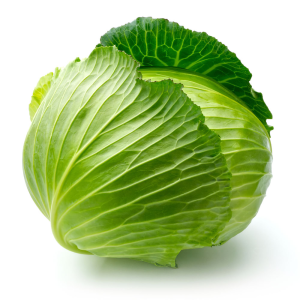Cabbage
 Overview
Overview
Cabbage is a member of the cruciferous vegetable family, a family that includes broccoli, cauliflower, Brussels sprouts, collards, kale, among other vegetables. Cabbage grows well in cool climates, and while there are a variety of different cabbages, red, green, and Savoy cabbage are perhaps the most common. Red and green cabbage has smooth leaves, while the leaves of Savoy cabbage are more ruffled and are yellow-green in color. The Savoy cabbage also has a milder flavor than red or green cabbage. The color of most cabbages’ leaves lightens toward the center as these leaves do not receive as much direct sunlight as the outer leaves. Fresh cabbage will have firm, dense, crisp leaves that are free of cracks or bruises. Fresh red and green cabbage can be stored in the refrigerator for up to two weeks, while Savoy cabbage can be stored in the refrigerator for about one week.
History
Cabbage has been a part of humans’ diets for a very long time. It originated in Asia and was introduced into Europe around 600 B.C.E.; since it is relatively easy to grow and maintain, it spread throughout Eastern Europe fairly quickly. Early German settlers brought cabbage to the United States. Russia, Poland, China, and Japan are among the world’s major producers of the vegetable.
Nutritional Information
Cabbage is very rich in nutrients and has many cancer-fighting properties. It is a great source of vitamin B6, potassium, biotin, calcium, folic acid, magnesium, manganese, among other nutrients. While cabbage is also rich in Vitamin C, the content of this vitamin diminishes once the vegetable is cut. Cabbage is also a good source of glutamine, an amino acid that can have anti-inflammatory effects, help regulate the immune system, and may support intestinal health. While it is packed with nutrients, cabbage is also a good source of fiber: a 3.5 ounce serving of cabbage contains over three grams of fiber, about two grams of protein, less than one gram of fat, no cholesterol, and only 35 calories.
Glucosinolates are compounds found in cabbage that are predominantly responsible for its cancer-fighting properties. These compounds help rid the body of toxins and help prevent damage from free radicals. Sulforaphane is one particular type of glucosinolate that increases the production of specific enzymes, enzymes that combat carcinogens and free radicals; this particular compound is also linked to a decreased risk of prostate cancer. Cabbage also contains the same type of antioxidants found in blueberries that help combat cardiovascular disease and have anti-inflammatory properties; they can also help prevent tissue damage that can result from inflammation. The specific antioxidant responsible for these effects is a flavenoid called anthocyanin; it has been found to be among the most powerful of over 100 flavenoids.
Cabbage contains another kind of phytochemical called indoles that are particularly helpful in fighting breast cancer. These compounds alter the way the body uses estrogen, which ultimately helps prevent the development and spread of breast cancer. Estrogen contains three metabolites: two carcinogenic, “bad,” metabolites and one metabolite that offers protective qualities. Indoles work to increase the ratio of “good” metabolites to “bad” ones, thus helping protect against breast cancer.
Health Benefits
Considering the wealth of nutrients contained in cabbage, it is rather unsurprising that this vegetable also offers many health benefits, not the least of which is protection from certain kinds of cancer. Studies have shown that women who live in eastern European countries are less likely than American women to suffer from breast cancer, at least partly because of the increased amount of cabbage in their diets. Because of the phytochemicals indoles included in cabbage, breast cancer is less likely to develop and spread in people who eat a relatively high amount of cabbage. Furthermore, the glucosinulates in cabbage help eliminate harmful chemicals and hormones from the body, which can also help prevent cancer. Studies have found that higher intakes of vegetables from the cabbage family are linked to lower rates of cancer, particularly breast, lung, prostate, and colon cancer.
Furthermore, cabbage has been shown to be especially helpful in the treatment of ulcers. The amino acid glutamine helps cells that line the gastrointestinal tract regenerate, which helps relieve ulcers. In fact, research conducted in the 1950s found that people suffering from ulcers who consumed fresh cabbage juice noticed a significant change in their condition within seven days.
References
- Holford, P. The optimum nutrition bible, Little Brown Group (2004)
- Holford, P & Lawson, S. Optimum Nutrition Made Easy How to achieve optimum health, Piatkus Books (2008)
- Murray, M.T. et al., Encyclopedia of healing foods, London : Piatkus (2005)
- The National Research Council. Recommended Dietary Allowances, 10th ed, National Academy of Sciences (1989)
- Werbach, M. Nutritional Influences on Illness, 2nd ed, Third Line Press (1993)
Posted in Cabbage
Ask a Question Or Join a Discussion


